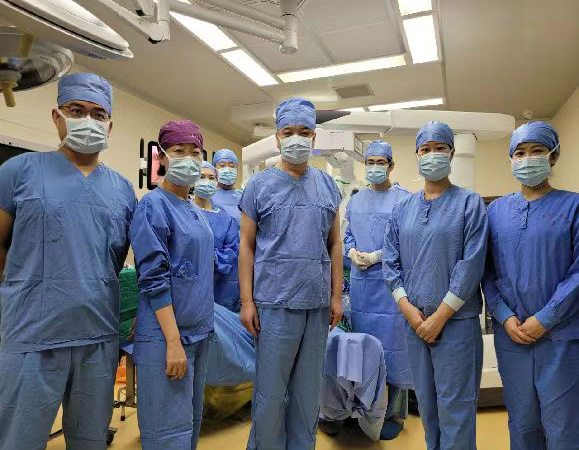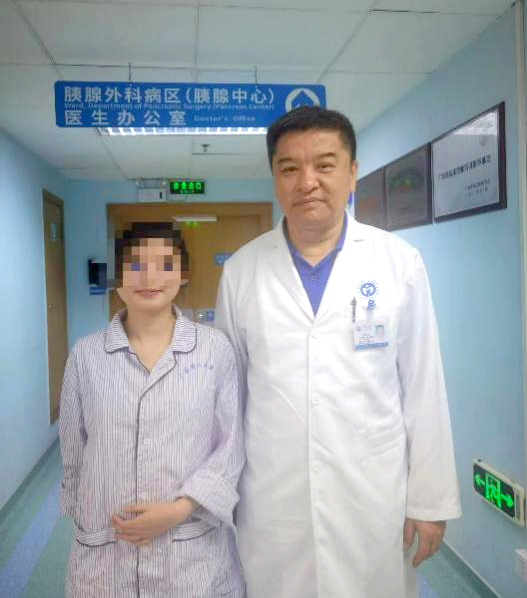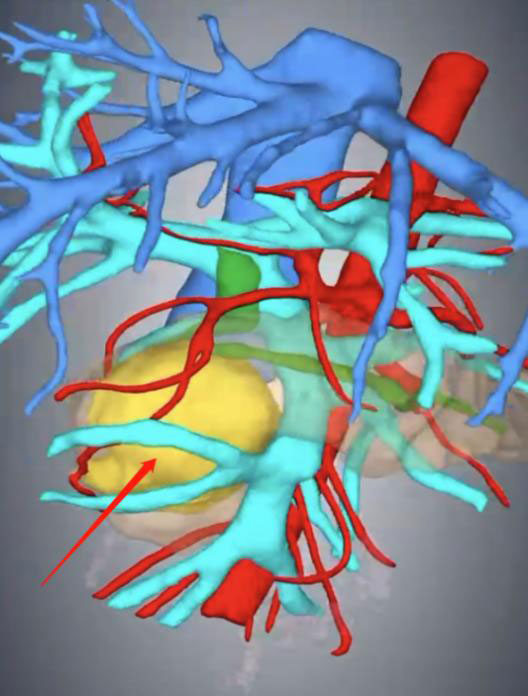

Known as the “pearl” of abdominal surgery, pancreatic surgery is one of the most complicated and risky surgeries in general surgery. Common surgical methods for pancreatic cancer include pancreaticoduodenectomy, resection of the pancreatic body and tail and spleen, and total pancreaticoduodenectomy, etc. Those surgeries have a wide range of resections, involve multiple organs, and often lead to postoperative dysfunctions of pancreatic internal and external secretion, such as pancreatogenic diabetes, digestive malabsorption caused by pancreatic enzyme deficiency and other problems. For benign and low-grade malignant tumors of the pancreas, pancreatic surgery that preserves organs and functions can offer more benefits to sufferers, making it an increasingly attractive option. Under the leadership of Professor Chen Rufu, our Pancreas Center has fully utilized the advantages of the Da Vinci Surgical System and has routinely performed pancreatic surgeries that preserves organs and functions, achieving satisfactory results.
Two years ago, Ms. Chen (pseudonym), 28 years old, unexpectedly discovered a tumor with a diameter of about 4cm at the uncinate process of her pancreas during a physical examination. It was considered a pancreatic cystic tumor. This was a benign tumor. If the tumor was located in the body or tail of the pancreas, a partial pancreatectomy with a very low postoperative recurrence would have been feasible. However, if the tumor was located at the head of the pancreas, laparoscopic pancreaticoduodenectomy was often chosen as the surgical method. This procedure involves a large resection range, poses a high risk of postoperative complications, and has a long-term impact on quality of life. Ms. Chen went to several major hospitals for medical advice and all doctors suggested that pancreaticoduodenectomy was necessary in case of surgical resection. With a large resection range and high difficulty, Ms. Chen was not only faced with the risk of serious postoperative complications but the long-term impact on quality of life due to extensive reconstruction of the digestive tract. Ms. Chen hesitated for 2 years and still could not make up her mind to undergo the surgery.
Upon knowing that Professor Chen Rufu at the Pancreas Center of Guangdong Provincial People’s Hospital is an authoritative expert in the field of pancreatic surgery, Ms. Chen placed high hopes on him and came for consultation and treatment. After learning about her actual situation, the multidisciplinary team led by Professor Chen Rufu decided to perform pancreatic head resection with the assistance of the Da Vinci robot in order to minimize surgical trauma, maximize complete tumor resection, maximize preservation of organ function, and reduce the impact on normal physiological functions. During the surgery, the team of Professor Chen Rufu fully leveraged the strengths of the Da Vinci surgical robot, such as ultra-high-definition 3D image enlargement, a flexible robotic arm, and automatic image filtering and dithering. They successfully performed minimally invasive fine operations, such as lymph node dissection and anastomosis of pancreas intestine, gallbladder intestine and gastrointestinal tract. The amount of bleeding during the surgery was only about 50 milliliters.

Multidisciplinary Surgical Team
After awakening up from anesthesia, the sufferer got rid of the tracheal intubation and was transferred to a regular ward. On the first day after surgery, Ms. Chen was able to get out of bed and move around. She was smoothly discharged within 10 days after the surgery. Upon discharge, Ms. Chen recovered well and felt that her eating, digestion, and other conditions were the same as before the surgery.

Photo of Professor Chen and restored Ms. Chen taken before discharge
“This surgery (duodenum-preserving pancreatic head resection (DPPHR)) removes the head of the pancreas only without removing other organs. This procedure allows for complete lesion removal while preserving the integrity of the upper gastrointestinal organs, resulting in less impact on the sufferer’s postoperative life and a low occurrence of postoperative complications. Thus, this surgery is much more difficult than pancreaticoduodenectomy.” explained Professor Chen Rufu. “As an advanced laparoscopic robot platform, the Da Vinci Surgical System is currently the most advanced laparoscopic minimally invasive system. By leveraging the strengths of the robot, it can improve the success rate of such surgeries and maximize sufferer safety and surgical efficacy.
It is reported that in addition to Ms. Chen’s DPPHR the team of Professor Chen Rufu has routinely carried out multiple difficult and precise surgeries that preserve organs and functions with the help of laparoscopy and minimally invasive technology assisted by robots, including the following three surgeries. (1) Spleen-preserved resection of pancreatic body and tail: it is suitable for benign and low-grade malignant tumors in the body and tail of the pancreas and is currently one of the most widely used surgical methods in robot-assisted pancreatic surgeries. Compared with traditional laparoscopic surgery, the Da Vinci Surgical System could separate and cut off the small arteriovenous branches between the spleen and pancreatic body and tail more finely, which improves the success rate of spleen preservation greatly and benefits sufferers. (2) Local resection of pancreatic tumors: it includes enucleation of pancreatic tumors and is suitable for smaller benign tumor of pancreas, neuroendocrine tumor, and other low-grade malignant tumors. Local resection of pancreatic tumors with the help of the Da Vinci robot can maximize the preservation of pancreatic tissue and function, avoid damage to the main pancreatic duct, and reduce surgical time and bleeding. After the surgery, sufferers recovered rapidly with good long-term efficacy. (3) Middle pancreatectomy: it is suitable for benign and low-grade malignant tumors on the neck and body of the pancreas and removes the anterior and posterior parts of the pancreas (including the tumor) only. With a high-definition field of view and high stability, the Da Vinci Surgical System can accurately separate the resected pancreas from the surrounding splenic arteries and veins, ensuring a high success rate of surgery.
For benign and low-grade malignant pancreatic tumors, Professor Chen Rufu led his team to conduct a thorough preoperative evaluation, adopted personalized surgical plans, utilized the advantages of 3D high-definition precise robot systems, and then carried out various pancreatic surgeries that preserve organs and functions. They have completed more than 200 cases. They have not only enabled sufferers to recover quickly and safely after surgery but also bring more benefits to sufferers’ long-term quality of life. He stressed, “As surgeons, we have always been committed to helping sufferers between minimal trauma and optimal recovery. With a minimally-invasive surgery rate of over 95%, now the team of our Pancreas Center has mastered all minimally invasive pancreatic surgeries. We can make personalized choices based on the sufferers’ needs, using traditional laparoscopic minimally invasive technology or robotic surgery. He further stated, “The continuous development of medicine and technology ultimately benefits sufferers. We will explore further to provide technologies of higher quality and better services for sufferers.” Professor Chen Rufu will continue to lead his team to pursue personalized and precise diagnosis and treatment of pancreatic cancer, striving to promote the diagnosis and treatment of pancreatic cancer to a new height.

Accurate evaluation of the relationship between the tumor (yellow area pointed by the red arrow) and surrounding blood vessels using preoperative imaging 3D reconstruction
Pancreas Center
Updated: July 28, 2023